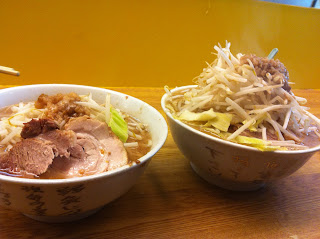One of the things I think is most interesting between America and Japan is the concept of ramen.
First let me give you a bit of history. Ramen was originally a Chinese dish. That is why when you see the word ramen in Japan it is almost always in katakana characters; katakana are used expressly when a thing or name is borrowed from a different culture (hence foreigner names are almost always in katakana). Long ago, Japanese people discovered this dish and loved so much they adopted it into their culture and then proceeded to modify it to make their own original style.
Today there are a great many ramen shops. Where I live there are 3 within walking distance, and I live in no popular area. In Kyoto there is a complete ramen district where many people flock to try many different original flavorings of the local ramen shops. All in competition with one another, they strive hard to make their own dish unique and original in order to gain a following. This is also a popular place to study the art or ramen culture and production.
From the Kyoto ramen shops. Pork fat ramen. It comes in different sizes.
But these are places where the majority of customers are men. It is a cultural thing where women just aren't seen too often here, especially if they have any social standing. For whatever the reason women do not frequent this place, especially not alone; it seems to be more acceptable if they enter in a pack or when accompanied by a man. Speaking of this, there are several 'men's places' that I have come to discover, including: pachinko slots, ramen shops, and arcades. It is also my own personal theory that men frequent karaoke joints more than women too.
There are many different types of ramen. It seems to me that every prefecture has their own special recipe for it. The differences mostly consist of the broth, whether it is soy, miso, pork bone or salt, but there are also a lot of different 'dressings' if you will; there are different vegetables, as well as meats that adorn the ramen. Personally I a fan of both pork bone and miso ramen.
The birth of miso ramen is an interesting one. I read recently that miso ramen was created up near Sapporo Hokkaido and was discovered when some Japanese business men from down south were in a restaurant and the owner saw them dipping their noodles into the miso soup before they ate them. Upon seeing this the restaurant owner decided to experiment with miso soup as a broth for ramen.
A more affluent ramen shop located in Esaka and their delicious pork bone ramen
Wakayama soy based ramen from a wonderful hole in the wall ramen shop.
In addition to the difference of ramen culture, there is also a difference in instant ramen culture as well. The ever familiar and popular cuisine of many college students, might not quite be the same as your favorite brand from across the pond. During my time here, I have not seen a single familiar brand of instant ramen that I favorited back in America (though I am pretty sure Cup Noodle is here, I just haven't seen it yet since others are more popular).
In addition to the pop culture dish, there is also a dedicated museum





















